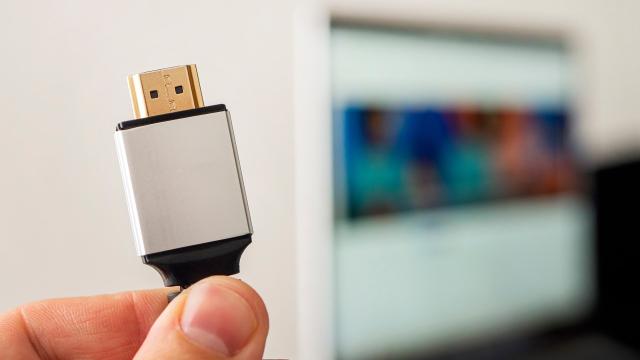The HDMI cable has been around for some time now but its standards are continually improving. The latest and greatest in HDMI technology is HDMI 2.1.
You may have heard that HDMI 2.1 is great for next-gen gaming, but there’s slightly more to it than that.
For starters, what’s HDMI?
HDMI stands for High-Definition Multimedia Interface. At a basic level, it’s a set of standards used for transmitting audio and video data between devices.
You may remember the days of connecting yellow, red and white AV cables between your devices and your TV. Well, the HDMI can transmit both video and audio data in one cable and has essentially phased out AV cables for displays.
To use HDMI, you’ll need 2 HDMI compatible devices and an HDMI cable to connect them. This normally applies to things like connecting your TV and gaming console or computer and monitor.
The thing to remember is that the HDMI standards in both the cable and both the compatible devices have an impact on video and audio output. If they are different standards you might not get the best of all HDMI features
What is HDMI 2.1?
HDMI 2.1 is currently the highest standard for transferring video and audio content between devices. It’s a level up from the previous HDMI 2.0 standard.
The thing with HDMI 2.1, is that its not as easy as just supplying the fastest video and audio. There are a whole bunch of specifications that make up HDMI 2.1 and manufacturers need to utilise a number of them in order to advertise that they support this standard.
The latest gaming consoles such as the PS5 and Xbox Series X are HDMI 2.1 compatible and in return HDMI 2.1 has a number of gaming-focused features such as VRR, QFT and ALLM. But to fully support these features, TVs and monitors also need to implement them.
So, what are the new technical specifications of HDMI 2.1?
Video resolution
According to the HDMI website, 2.1 supports higher video resolutions and faster refresh rates such as 8K at 60 FPS and 4K at 120 FPS. It’s even ready for 10K resolutions whenever that becomes a thing.

HDMI 2.1 supports both compressed and uncompressed modes but it’s up to manufacturers as to whether either or both are used.
Dynamic HDR
Then there’s HDR (high-dynamic range), which influences the visual appearance of an image. HDMI 2.1 supports both static and dynamic HDR options. Dynamic HDR basically ensures that every second of video is displayed at optimal depth, detail, brightness and contrast.
This means that where HDR enhancements are available in movies, tv shows, games etc. HDMI 2.1 can support this format.
eARC
Enhanced Audio Return Channel (eARC) is a feature of HDMI 2.1 that supports the best audio standards.
It can handle up to 192kHz, 24-bit and uncompressed 5.1, 7.1 and 32-channel audio as well as theatre quality enhancements such as Dolby Atmos and DTS Master.
It also allows this enhanced audio to transmit through a TV to a soundbar or an AVR sound system.
Variable Refresh Rate
One of a number of gaming features that HDMI 2.1 supports is VRR. This reduces lag, judders and frame tearing for smoother gameplay. It allows your console to deliver video frames as fast as it possibly can by giving time for each frame to render properly before its transmitted.
Auto Low Latency Mode
Another gaming optimised feature, ALLM is all about sending the ideal image from your device to your screen. This is often advertised as Game Mode. ALLM lets a console tell your display to switch to a low-latency and low-lag mode for gaming.
It’s basically an automated feature that will tell your TV to switch to a better mode for gaming and then detect when it needs to switch back for watching a movie or video.
Quick Frame Transport
The third great gaming feature that HDMI 2.1 provides is QFT, which helps to reduce display latency. This is basically the transport time of a frame from the source device to the display. It impacts the responsiveness of games such as the time between when a button is pressed and the action is seen on screen.
Quick Media Switching
Lastly, there’s QMS, which is pretty much exactly what it sounds like. QMS eliminates the time a black screen is displayed when switching video modes. It allows for a smooth transition between frame rates thanks to VRR and avoids blank screens for a seamless experience.
You’ll also need a new cable
A key component of HDMI is the cable and with a new standard comes a new cable. Some devices, such as the PS5 and Xbox Series X come with these new high-speed cables included, but if not you’ll need to seek one out for yourself.
When looking for an HDMI 2.1 compatible cable it needs a few things on the box to be certified such as the HDMI Ultra High-Speed Cable logo on the packaging and on the cable itself.
Do your research
Now you know all the new things provided by HDMI 2.1. The thing is, manufacturers don’t need to uphold all of these new features to claim the licence of HDMI 2.1.
So when choosing a display or device make sure to do your research and check the specs to see if it supports the specific HDMI 2.1 features that are important to you.

Comments